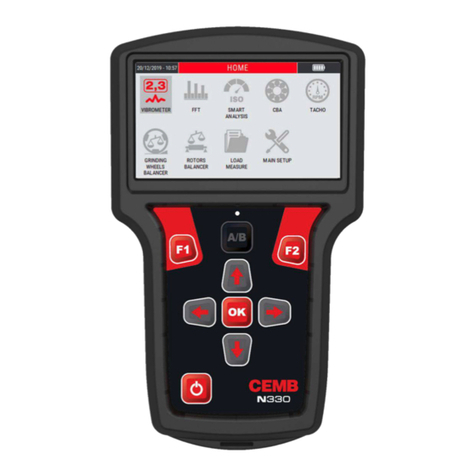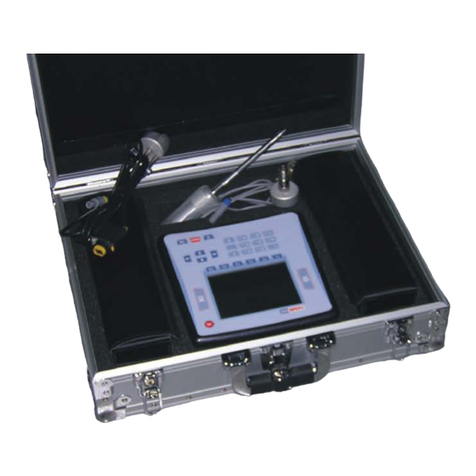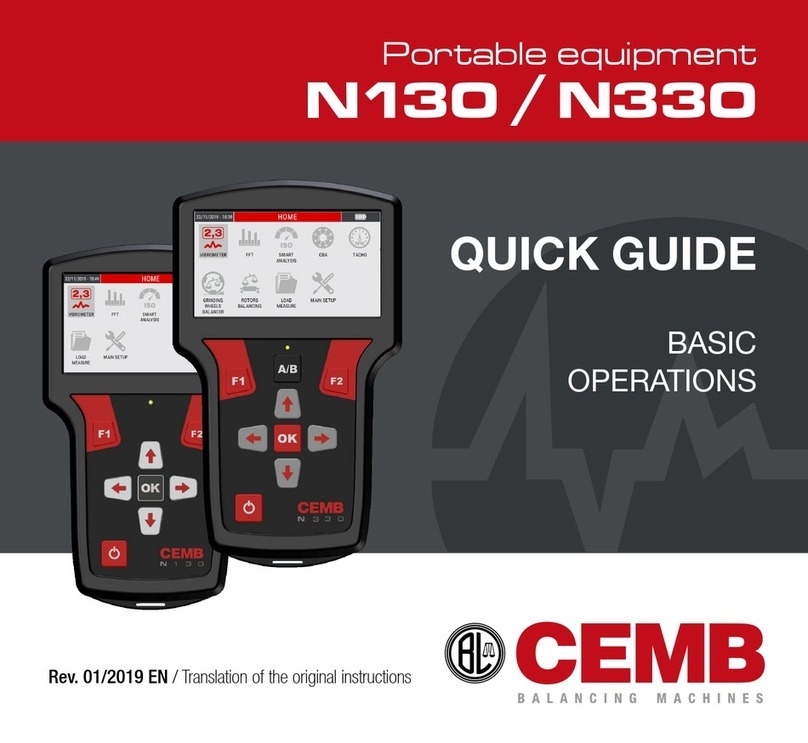
Vibration equipment division
N200 - Ver. 1.0 11/2016
1.4 reset switcH
In some special circumstances, CEMB customer service may advise you to reset the N200 instrument. To do this, press the
buttonlocatedonthelowerpartoftheinstrumentusingasmallobjectwitharoundedtip.Itispurposelylocatedinadifcult
to access area to prevent it from being reset unintentionally.
————————————————————————————————————————————————————
warninG!
intHe eVent of an error tHat cannot be reset automatically, tHe messaGe "err" will be displayed on tHe screen
followed by tHe number identifyinG tHe error tHat occurred.
sHould tHis situation occur, tHe instrument must be reset manually by pressinG tHe reset button.
————————————————————————————————————————————————————
warninG!
donot use pointed objects sucH as needles, puncHes or sucHlike to press tHe reset button as tHey could damaGe it.
————————————————————————————————————————————————————
The N200 instrument is provided with a built-in rechargeable lithium battery, which allows autonomy of more than eight hours
under normal operating conditions of the instrument.
The battery status is indicated by an icon in the upper right hand corner of the screen.
battery fully charged
battery partly charged
batteryalmostat(batteryliferemainingwhenthisappearsisapprox.onehour)
batteryat:rechargewithin5minutes
Ifthebatteryisatandtheinstrumentisnotrechargedwithin5minutesitwillswitchoff.
This would interrupt any active measurements not yet saved.
Whenthebatterychargerisconnectedthedisplaylightsupbrieyindicatingtheconnection,evenwhentheinstrumentis
switchedoff.Thebatteryiconremainsanimatedwhentheinstrumentisrecharging,progressivelyllingup.Whencharged,
the animation stops and the ‘battery fully charged’ icon is shown.
————————————————————————————————————————————————————
warninG!
wHen connectinG tHe battery cHarGer, first insert tHe connector into tHe releVant socket on tHe n200 instrument;
only pluG it into tHe power supply socket wHen tHis Has been done.
wHen recHarGed, unpluG tHe battery cHarGer from tHe power supply socket before remoVinG tHe connector from tHe instrument.
————————————————————————————————————————————————————
warninG!
itis stronGly recommended to recHarGe tHe battery witH tHe instrument switcHed off: as recHarGinG is completed witHin less tHan fiVe
Hours sucH precaution preVents tHe battery cHarGer from beinG connected for an excessiVely lonG period of time (max. 12 Hours).
————————————————————————————————————————————————————
warninG!
tHe litHium battery is able to witHstand tHe recHarGinG-discHarGinG cycles, eVen on adaily basis, witHout problems but it could become
damaGed if allowed to be fully discHarGed. for tHis reason it is adVisable to recHarGe tHe battery at least once eVery tHree montHs,
eVen in tHe case of extended idle period.
————————————————————————————————————————————————————
































